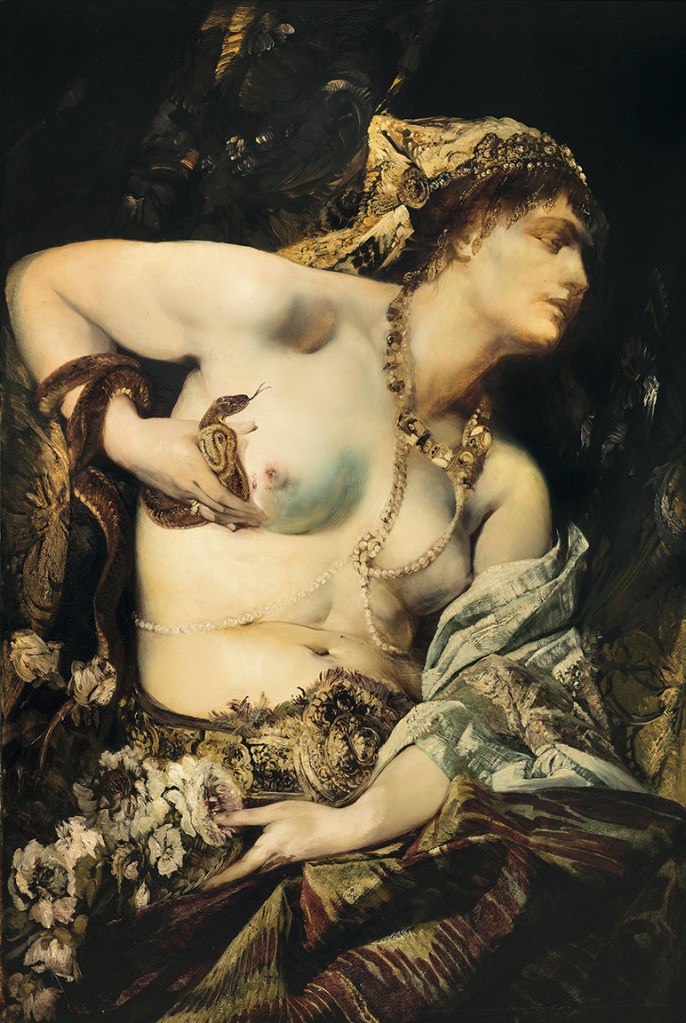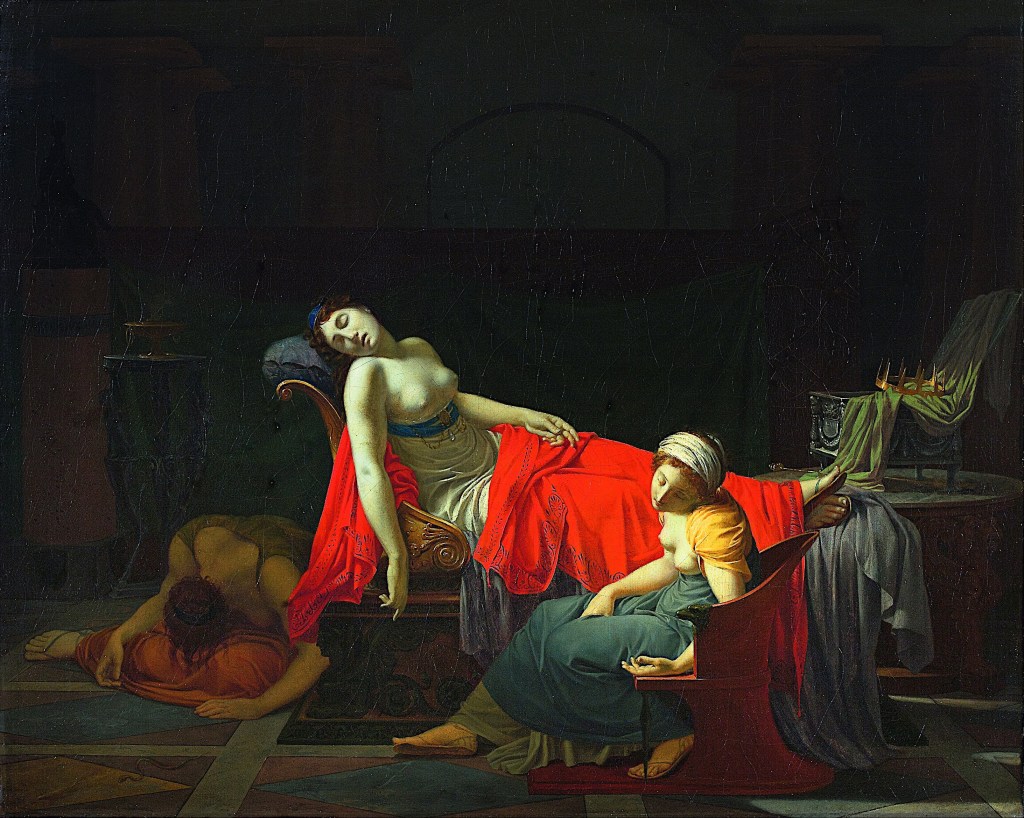The Death of Cleopatra, Hans Makart, 1875
I am a sucker for all the drama, the romance, the glamour and to some extent the orientalism surrounding portrayals of Cleopatra VII Queen of Egypt. I love the aesthetics of this 1875 painting above “The Death of Cleopatra” by Austrian painter Hans Makart—the asp circling her arm, coiling around her breast, a drop of blood on her breast seemingly where the snake has bitten, her torso contorted, her face and body bejeweled and bedangled. Makart’s painting of Cleopatra is a gorgeous example of 19th century orientalist painting, the genre of painting by white Western European men who exoticize “the East” and sexualize women from the Middle East, Asia and Africa. Cleopatra’s life story and death story have suffered this form of Western orientalist misogyny since her story began being told more than two millennia ago.
Cleopatra’s death (and its representation in art and literature) is one of the questions that intrigues me as I have delved into Cleopatra’s life and history. I am preparing to embody and “perform” and make photographs of Queen Cleopatra the VII of Egypt with photographer Luis Branco in Portugal in February as part of the “My Heroines” series. In my previous studies and representations of heroines Eve, Salome, Judith, Aphrodite, Sappho and Helen of Troy, I have researched these figures and their representations (and misrepresentations) in literature, mythology, paintings, performances, sculptures, films, and in contemporary feminist criticism. I have to assume a certain amount of hubris as well as openminded investigation and humor as I embody these historic women in my 60 something year old cis-gender white woman form.
Cleopatra the VII Philopater the last Ptolemaic ruler of Egypt was born in 69 BC and died in 30 BC. She ruled Egypt from 51 to 30 BC. Her life (and death) story was written almost exclusively by Greek and Roman men years after her death. The Greek historian and philosopher Plutarch is a primary source. Plutarch wrote his Parallel Lives around the beginning of 200 AD, more than 200 years after Cleopatra’s death. Parallel Lives describes the lives and the characters of important Greek and Roman men. Plutarch writes about Cleopatra primarily because of her relationships with Gaius Julius Caesar (Caesar) the famous Roman general and statesman and the infamous Marcus Antonius (Mark Antony) also a Roman general and politician and Caesar’s righthand man. Skepticism is important when reading Plutarch since the Greeks and the Romans were overtly critical and wary of this most renowned and wealthy Eastern Queen and of her relationship and hold over both Julius Caesar and Mark Antony. Whatever was the real story of Cleopatra’s love life, she bore Caesar’s only son and three of Mark Antony’s children and was one of the most powerful rulers of her time.
The Battle of Actium, Lorenzo A. Castro, 1672
To set the story for Cleopatra (and Mark Antony’s) demise and death—I begin with the Battle of Actium. After Caesar’s death/murder on the Ides of March in 44 BC Gaius Octavius (Octavian) was named as Caesars’ heir. There was an uneasy sharing of power amongst various leaders of the Roman Empire with lots of infighting and bloody battles, Romans against Romans. Mark Antony was said to have control of the East and Octavian of the West. To make a long story short, Octavian and Mark Antony (with the support and assistance of Cleopatra) fought it out for control at the Battle of Actium. The famous naval battle took place in the Ionian Sea between Octavian’s fleet (led by General Agrippa) and the combined fleet of Mark Antony and Cleopatra. Antony and Cleopatra’s fleet was ingloriously defeated by Octavian’s forces. Most of Antony’s soldiers defected to Octavian. Mark Antony fled with Cleopatra back to Alexandria, a broken soldier and man. Ultimately Octavian arrived in Alexandria wanting Antony’s head and Cleopatra’s wealth and control of her Egypt. He also wanted to drag Cleopatra back to Rome to display her and exhibit his bounty to the Roman people. Both Mark Anthony and Cleopatra died and or committed suicide in Alexandria sometime in August in 30 BC. It is most likely they died separately. I like the 1963 film version with Mark Anthony dying in Cleopatra’s arms and then her own suicide, very Romeo and Juliet-ish with a gender reverse.
For Cleopatra, whether death was by asp or the poison is a big question. Here are some of the many paintings of The Death of Cleopatra, all painted by Western European men. Cleopatra is shown as a white woman, though there is dispute about her racial heritage. The drama, the boobs, the snake, are all beautifully depicted.
Death of Cleopatra, Giampietrino, 1500
The Death of Cleopatra, Guido Cagnacci, 1645-55
Death of Cleopatra, Jean-Baptiste Regnault, 1796-97
The Death of Cleopatra, John Collier, 1890
The Death of Cleopatra, John Collier, 1890
Here is Plutarch’s account of Cleopatra’s death written more than two hundred years after her death:
“It is said that the asp was brought with those figs and leaves and lay hidden beneath them, for thus Cleopatra had given orders, that the reptile might fasten itself upon her body without her being aware of it. But when she took away some of the figs and saw it, she said: ‘There it is see, you see,’ and baring her arm she held it out for the bite. But others say that the asp was kept carefully shut up in a water jar, and that while Cleopatra was stirring it up and irritating it with a golden distaff it sprang and fastened itself upon her arm. But the truth of the matter no one knows; for it was also said that she carried about poison in a hollow comb and kept the comb hidden in her hair; and yet neither spot nor other sign of poison broke out upon her body. Moreover, not even was the reptile seen within the chamber, though people said they saw some traces of it near the sea, where the chamber looked out upon it with its windows. And some also say that Cleopatra’s arm was seen to have two slight and indistinct punctures; and this Caesar (Octavian) also seems to have believed. For in his triumph an image of Cleopatra herself with the asp clinging to her was carried in procession. These, then, are the various accounts of what happened”
Plutarch, Life of Anthony, 86. Translated by B. Perrin
The Death of Cleopatra, Edmonia Lewis, 1876
I would like to conclude with one of my favorite representations of The Death of Cleopatra. In my research I came upon a remarkable 1876 sculpture of Cleopatra by Edmonia Lewis. Edmonia Lewis was an American sculptor of mixed African American and Native American heritage. Lewis was born “free” in New York in 1844, she died in London in 1907. Edmonia led a remarkable and difficult life, ultimately finding refuge in the international art community of Rome in 1865. Her monumental sculpture “The Death of Cleopatra” was shown in the 1876 Centennial Exposition in Philadelphia and was both fervently admired and controversial in her portrayal of Cleopatra’s death. Edmonia Lewis was one of the few women artists of color working in the US at this time and the only woman of color exhibiting in the Centennial Exposition. Her representation of Cleopatra’s death has an integrity about it that you just don’t see in other representations of Cleopatra; there is not a sexualization of Edmonia’s Cleopatra though her breast is bared and she is certainly beautiful. Cleopatra leans back in her throne, an informality and peacefulness in her death. Cleopatra is not a drama queen here. Lewis purposely represents Cleopatra as a white woman. Edmonia Lewis’s representation of this powerful and controversial Queen in the hour of death is graceful, intimate and regal.
I leave for Portugal for the Cortico Artist Residency February 1st and I will be embodying Cleopatra and the Egyptian goddess Isis.








Dear Sherry,
In eyes, you are quite remarkable and I have learned so much for your emails, during these years you have been delving into the lives of the women you are are attracted to, as in your Heroine series.
Thank you for all you blogs. emails and updates on your creative processes and projects.
Love,
Janny
>
LikeLike
Dear Janny, Thank you for your lovely comments. I miss you and I wish we could talk about all these things in person. xoxoxoxo Sherry
LikeLike
These are very interesting. How do I save them? Suzie
LikeLike
Sherry, I found your post fascinating. Ever since Elizabeth Taylor was Cleopatra, I’ve been tantalized by her beauty. Very interesting to see these other paintings of her. I can’t wait to see your enacted photographs of her!
LikeLike
Yes Stefanie, Cleopatra is an amazing figure, as was ET in the 1963 film. xo Sherry
LikeLike